![]()
![]()
|
|
|
Pond Page
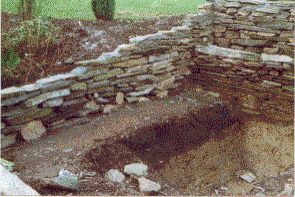
January 1999
The location of the pond was decided just after we moved in November 1995, We had a well stocked pond in our previous garden in Hampshire and we enjoyed sitting by it with a drink of coffee or perhaps something a bit stronger on occasions and watch the fish and other wild life in and around the pond, a most relaxing occupation.
This cottage is situated in an old lead/silver mining area that was active from the 1840s until deep mining operations ceased in 1885, during that period 4 mines were operating within a radius of 3/4s of a mile. Surface operations egg, recovery of minerals (silver lead and arsenic etc,) continued well into the 1930s.
|
|
|
Barn 1850 |
Cottage 1999 |
Cottage and pond |
The cottage is now a plain rectangle and the separate area is approximately where the pond is now located. When the excavation started a stone surface was uncovered which turned out to be the remains of part of the back of the now demolished rear section of the barn, the side wall was also uncovered just below the surface of the lawn, at this point all the designs that had been considered went out the window as it had now become somewhat of an archaeological dig.
Having found the remains of the side and rear walls of the old barn it was decided to carefully excavate the ground within this area and use the stone walls as a boundary feature for the pond area. In the rear wall a pair of 30" square well worn slate slabs were found and it is probable that these formed the threshold to the rear doorway, these have been incorporated into the paved surround.
As you will see from the photographs, the ground rises away from the back of the cottage so what starts off as a 12" deep hole at the front becomes 6' deep at the rear.

January 1999
This made very hard work of removing the soil etc when the lower levels were reached, but the first levels were quite easy as it had been infilled with a reasonable topsoil, beneath this a layer of furnace clinker was found, this was about 9" thick and probably came from the mine boiler house across the road thus dating it to the latter part of the 19th century. Also discovered in the clinker layer were the rusting remains of two miners picks and the rotten stumps of three wooden posts, these could have been either roof or partition supports, the upper surface of the clinker was clean so it is thought that this area of the barn had been used for dry storage rather than shelter for animals. This was probably in use until the barn was converted into two cottages around the turn of the century.
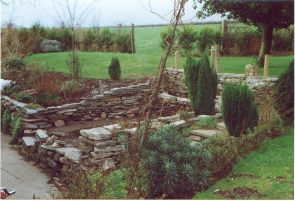
February1999
Below this clinker layer was the normal subsoil for this area which is a mixture of clay and shale known locally as shillet, this stuff is hard going and had to be loosened with a pick axe before it could be removed, I was trying to achieve a final water depth of 30" so that the fish could get deep enough to survive the hardest winters.
The front part of the excavation is to be used as a bog garden so the depth here is only 12" , all of the completed excavation was lined to prevent any damage to the tough PVC liner, the base was covered with a layer of builders sand and the sides with old carpet and old polyethylene fertilizer sacks. On the front and left hand side the liner was held in place with the paving but at the rear and right hand side, as these were vertical surfaces, a honeycomb brick and stone wall was built inside the liner to both support and hide it from view. Before the paving was laid a flexible conduit was installed from the cottage to take the electricity supply to the fountain/waterfall pump to be sited on top of a column in the centre of the pond. A Hozelock Super Cascade 1500 pump was chosen to do this work, this will feed water to the fountain in the centre and any surplus will go to the hollow log in the left hand rear corner and thence out into the pond.
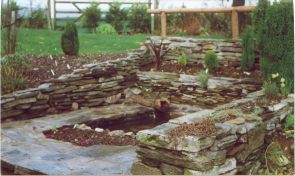
March1999
The pond was filled at the end of February 1999 and a bucket of mud from a local pond was introduced to add whatever natural microscopic life was present so that the naturalizing process would be as quick as possible. Also added at this time was a quantity of frog and toad spawn, hopefully to produce enough adults to get the local plague of slugs under control, and a handful of oxygenating weed. No fish were introduced at this time, this was left for four months to let things settle down, 16 fish were put in in July, a mixture of Goldfish, Sarasa Comets, Golden Orfe, and Shubunkins, things have gone quite well as we have only lost 3 fish in the first year, and we were given 4 fish by a friend, one of which must have been pregnant as there are at least 2 young ones around about 2" long.
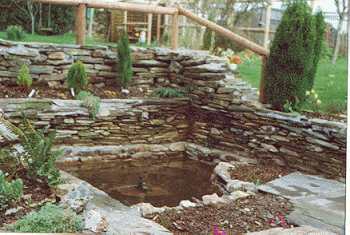
March 1999
The planting in the pond consists of 2 Water lilies, one white and fragrant and one pink, and they both bloomed in their first year, Pontederia Cord (Pickerel Weed), Alisma plantago-aquatica (Water Plantain), Myriophyllum aquaticum(Parrots Feather) and a blue Iris. The two areas of bog garden were planted with a yellow Iris, Astilbe, Caltha Paulstris (Marsh Marigold), Hosta 'Undulata', Primulas, Scrophularia Aquaticum variagata 'Limelight', Fuchsia 'Garden News' and bedded in the summer with blue Ageratum or something similar as annual bedding changes from year to year.
The raised bed at the back of the pond is planted with 3 miniature conifers, a prostrate Juniper and a Cordyline Australis 'Atropurpurea' to give year round colour and form, other planting includes Aubretia, Osteospermums and miniature daffodils.
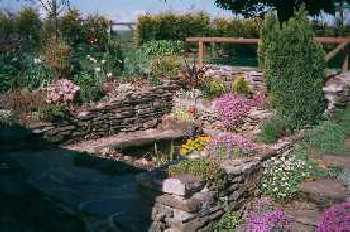
May 2000
You can compare this view of the pond in May 2000 with March of the previous year. Take a look in particular at the Castlewellan Gold conifer hedge at the top of the photograph and notice the growth that has taken place in two years, this will make a superb break for the westerly winds when it has grown to a height of 8 to 10 feet.
Home page |Next page| Garden page| Garden page2|Garden page3|Garden page4| Dowsing page| Korat page| Pergola page| Pond page| May Day page |Yearly progress